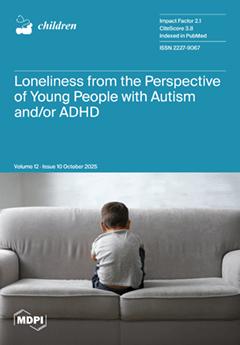Background/Objectives: Self-perceptions in childhood shape motivation, behavior, and well-being; however, their relationship to motor competence and physical fitness remains unclear. We tested whether physical fitness mediates the association between motor competence and domain-specific self-perceptions in middle childhood. Methods: In a school-based sample of 100 ten-year-olds (59 girls, 41 boys; 3 exclusions ≤ 5th MABC-2 percentile), children completed MABC-2 (motor competence), EUROFIT (physical fitness), and SPPC (self-perceptions). Principal component analysis of the nine EUROFIT tests yielded two factors: Motor Fitness (agility/endurance/flexibility/muscular endurance) and Strength/Size (handgrip and BMI). Parallel mediation models (MABC-2 → [Motor Fitness, Strength/Size] → SPPC) were estimated with maximum likelihood and 5000 bias-corrected bootstrap resamples. Benjamini–Hochberg FDR (q = 0.05) was applied within each path family across the six SPPC domains. Results: In baseline models (no covariates), Motor Fitness → Athletic Competence was significant after FDR (β = 0.263,
p = 0.003, FDR
p = 0.018). Associations with Scholastic (β = 0.217,
p = 0.039, FDR
p = 0.090) and Social (β = 0.212,
p = 0.046, FDR
p = 0.090) were positive but did not meet the FDR threshold. Strength/Size showed no associations with any SPPC domain. Direct effects from MABC-2 to SPPC were non-significant. Indirect effects via Motor Fitness were minor and not supported after FDR (e.g., Athletic: β = 0.067,
p = 0.106, 95% CI [0.007, 0.174], FDR
p = 0.251). In BMIz-adjusted sensitivity models, Motor Fitness remained significantly related to Athletic (β = 0.285,
p = 0.008, FDR
p = 0.035), Scholastic (β = 0.252,
p = 0.018, FDR
p = 0.035), and Social (β = 0.257,
p = 0.015, FDR
p = 0.035); MABC-2 → Motor Fitness was β = 0.235,
p = 0.020. Some paths reached unadjusted significance but were not significant after FDR correction (all FDR
p-values = 0.120 for indirect effects). Conclusions: Functional Motor Fitness, but not Strength/Size, showed small-to-moderate, domain-specific links with children’s Athletic (and, when adjusting for adiposity, Scholastic/Social) self-perceptions; mediated effects were small and not FDR-supported. Findings highlight the salience of visible, functional performances (e.g., agility/endurance tasks) for children’s self-views and support PE approaches that foster diverse motor skills and motor fitness. Because the study is cross-sectional and BMI-adjusted analyses are presented as robustness checks, caution should be exercised when interpreting the results causally.
Full article






